Commentary

AT A SCIENTIFIC conference held in June, researchers from two U.S.-based biotech companies announced they had treated 44 patients suffering from beta thalassemia — a blood disorder, found primarily in Southeast Asia and Africa, that negatively impacts the production of hemoglobin and can lead to a shortened lifespan. In its most severe forms, frequent blood transfusions are needed. After the experimental treatment, 42 of those patients no longer needed any blood transfusions. Additionally, the companies reported treating 31 patients with sickle cell disease, which disproportionately impacts populations in sub-Saharan Africa, as well as approximately 100,000 Americans. After treatment, none of these patients continued to have the recurrent painful symptoms that often lead to hospitalization.
All these patients were treated with an innovative approach that depended on the gene-editing technology CRISPR (Clustered Regularly Interspaced Short Palindromic Repeats). In the coming months, the companies CRISPR Therapeutics and Vertex Pharmaceuticals will submit these treatments for regulatory approvals in Europe and the U.K.
As people of faith, what do we need to know about CRISPR, and how might Christians respond to its ethical challenges?
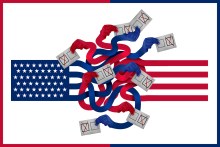
JUST AS FOR 50 years Ohio was a bellwether for presidential elections, since 2011 North Carolina has become a testing ground for Far Right legislation aimed at controlling federal election administration. In his book Indecent Assembly, author Gene R. Nichol says North Carolina is now “a laboratory for extremism.”
In September, the Supreme Court included on its docket a Republican-backed case out of North Carolina that pits voters against a state legislature that seeks to greatly increase its power over elections by limiting the ability of the state judiciary to review the actions of the legislature. This could potentially unbalance the fundamental checks and balances essential to a functioning democracy by giving one body total control over a function of government.
While the specific case of Moore v. Harper deals with whether the North Carolina state Supreme Court has the power to strike down state legislation that produced illegally gerrymandered voting districts, the federal Supreme Court will deliberate on whether the U.S. Constitution’s election clause, the primary source of constitutional authority to regulate elections, prevents a state judiciary from ordering a state legislature to comply with federal election laws.
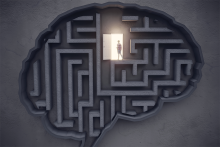
FOR 30 YEARS, I held an uncompromising conviction that abortion was murder. I preached against “child-killing,” suffered multiple arrests for blockading clinics, and had pro-choice groups successfully sue me. I led a national anti-abortion organization and directed the only large-scale annual pro-life event held in the U.S. Capitol. I personally appealed to Supreme Court justices to overturn Roe v. Wade.
Today, I no longer have these positions, and I did not applaud the recent reversal of Roe. I remain an evangelical by belief, but I now call myself a “pro-choice pro-lifer.” I have concluded that legislators and judges are not the people to try to resolve this complex, moral, social, and health-related question. Even among religions, there is no consensus on what constitutes permissible or impermissible abortion. Moreover, each woman’s experience with pregnancy is unique. Therefore, there can be no universal mandate forcing her to continue her pregnancy.
My transformation from an absolute to a nuanced position on abortion proceeded slowly and fitfully. Many exasperated old pro-life movement friends ask, “Whatever happened to you?” The short answer: empathetic listening. There came a moment when I realized I was doing all the talking and no listening on this subject. For nearly three decades, I had lived isolated in a fantasy where I presumed everything would work how it was supposed to, so I questioned nothing. In this fictitious pro-life world, all a woman in an unwelcomed pregnancy needed was to call out for help. In response, pro-life people would instantly help her, offering free housing, parenting supplies, medical care, babysitting, and, should she so choose, adoption. “With so much support,” I asked my audiences rhetorically, “why would anyone choose abortion?” I didn’t want answers.

WHAT MAKES THE parable of the good Samaritan so iconic and powerful? There’s a lesson about helping others in need, sure. But as Jesus taught a few chapters earlier, everybody helps those in their inner circle or who can pay them back (Luke 6:32-34). No, the point of the good Samaritan parable (Luke 10:25-37) is that really “loving our neighbor” looks like tangible service, at some cost to ourselves, even when it’s someone outside our ethno-religious group. “Good Samaritans” are the sorts of people Jesus wants to present to the world to say, “These are my representatives.”
These days, there’s tremendous concern about the rise of “white Christian nationalism,” and with good reason. I’ve spent nearly a decade documenting the impact of this ideology—the belief that America has been and should always be for “Christians like us”—on Americans’ political views and behaviors. The results are alarming. But one potential risk of our being genuinely concerned about the real threat of Christian nationalism is that young Christians can feel like any political participation is tainted or suspect—we wouldn’t want to be Christian nationalists, after all. On the contrary, Christian political involvement can be a tremendous witness when we think about what it means to be good Samaritans today.
Americans who subscribe to white Christian nationalism think in terms of in-groups and hierarchies. They believe their group made the nation prosperous and that their cultural and political power is being threatened by ethnic and religious outsiders, such as immigrants, Muslims, secular persons, LGBTQ persons, and those who challenge the racial status quo like Black Lives Matter. Because of this, the political goals of white Christian nationalism are fundamentally anti-pluralist and anti-democratic. The goal isn’t to include more voices; the goal is power for “us.”
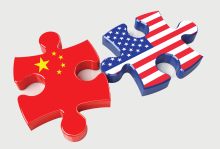
EVIDENCE OF THE rising power of China and the dangers of a bipolar China vs. U.S. battle for superpower dominance can be seen around the world. For instance, in May, I drove past hundreds of Chinese construction workers in Costa Rica building a China-funded highway. Dozens of shipping containers made up their roadside housing, each marked not in Spanish but with a Chinese character. Later that month, President Joe Biden traveled to South Korea to meet newly elected President Yoon Suk-yeol, who drew on growing public antipathy toward China in his campaign. In June, I was in Japan, where many voiced alarm about the Chinese government’s iron-fisted takeover of Hong Kong, asking whether Taiwan would be next.
My five years of experience in Northeast Asia as a representative of Mennonite Central Committee (MCC) prepared me for what I was hearing. Colleagues from Asia, Africa, and Latin America have told me that Chinese power is ubiquitous. In the Democratic Republic of Congo, for example, China and the U.S. are battling to dominate the world’s clean energy economy by controlling the mining of cobalt—a metal used in nearly every computer, cellphone, and electric car.
When I returned to New York in June, I resumed my front-row seat at the United Nations, where battles between the U.S. and China have paralyzed the UN Security Council’s ability to address global challenges.
Fears about China have implications close to home.

RUSSIAN THREATS TO use nuclear weapons in its war against Ukraine have made clear that the world urgently needs an inclusive, reality-based plan for nuclear safety: the total elimination of nuclear weapons. Faith communities have long recognized the moral depravity of these weapons and the unacceptable humanitarian consequences their use would pose.
People of faith have worked with the International Campaign to Abolish Nuclear Weapons (ICAN) to establish the first comprehensive international treaty to ban nuclear weapons, the Treaty on the Prohibition of Nuclear Weapons (TPNW). In June, the 61 states parties (nations) and 86 signatories of the treaty convened in Vienna for their first meeting since the treaty came into legal force in January 2021. Key topics of discussion were adding signatories to “universalize” the treaty, implementation, and reinforcement of norms against nuclear weapons. The meeting was critical to advancing key articles of the treaty, particularly assistance to victims of nuclear weapons and testing, remediation of contaminated environments, and setting deadlines for the elimination of nuclear weapons for nuclear-armed states that join the treaty.
As Alexander Kmentt, the Austrian president of the Vienna conference, put it, universalization means not only encouraging new ratifications but also “promoting the arguments on which the treaty is based, namely the humanitarian consequences of and the risks associated with nuclear weapons.”
In August, parties to another international nuclear weapons treaty, the Treaty on the Non-Proliferation of Nuclear Weapons (NPT), are gathering in New York.

A MAJORITY OF faith-based organizations have only one mission—to shepherd their adherents through life. However, these congregational mechanisms of faith can also be utilized for conflict early warning and early response (EWER). For decades, peacebuilders have used EWER systems to identify and analyze conflict trends, alert to conflict risk, inform decision-making, and initiate timely responses to prevent violent conflict.
In fact, religious bodies, particularly churches, are an emerging frontline of conflict early warning and early response. Churches are highly local with deep roots in communities. They build “organic” intra- and interfaith mechanisms that can mobilize to prevent political violence at the source. Faith-based early warning systems are a valuable tool for identifying emerging signs of community violence and for controlling in-group members to quell political violence. My research shows this is as true in Sri Lanka and Nigeria as it is in the United States.
Over the years, the field of conflict early warning has evolved from formal international institutions to more community-based mechanisms capable of preventing violence using local knowledge. Early warning systems have successfully prevented political violence and mass atrocities.

A YOUNG GIRL sits on her father’s shoulders at a women’s soccer game in California, where fierce women play on the field, wise women own the professional soccer club, and women on the U.S. national team just won the right to be paid equally. The father locks eyes with Abby Wambach, a veteran in the fight for equal pay and a winner of two Olympic gold medals and a World Cup title. The father points up to his daughter and shouts to Abby: “This is the only world she’ll ever know.”
It’s commonplace for institutions to fail to honor a woman’s worth—from rulings in domestic violence cases to recent decisions from the highest courts that restrict reproductive options. But the U.S. Women’s National Soccer Team is not common. And they are not used to losing. The team, which has won four World Cups and four Olympic gold medals, is considered the world’s best women’s soccer team, and yet the players’ efforts to be compensated fairly have been an uphill battle for decades. For instance, under the most recent collective bargaining agreements, a player on the women’s team, according to The Washington Post, would earn about 89 percent of the compensation U.S. men received for a series of exhibition games. That disparity was true in 2018 and 2019, when the U.S. women won the World Cup and the U.S. men failed to qualify for the tourney.
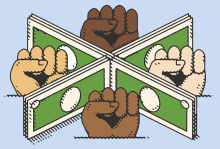
WE HAVE BUILT an entire political economy that relies on racism. We can no more give up the racism than we can give up the political economy that funds our lives. Racism persists because racism works. It does not, of course, work for all of us — but that is somewhat the point.
Racism naturalizes what are obviously unnatural relationships forced between value and labor and land and bodies. As the ultimate gaslighting move, racism blames the oppressed for their oppressions, claiming it is something “natural” about them, something about their “race.” This naturalization attempts to justify the morally unjustifiable and makes what is obviously evil, idolatrous, and abhorrent look good, true, and beautiful. Following the Black radical tradition, we can call this gaslit normalization of domination and exploitation “racial capitalism.”
Racial capitalism has built into its politics a divide-and-conquer strategy. The Black Marxist Oliver Cromwell Cox laid this out in 1948 when he observed that poor whites, migrant Chinese, and Jim Crow-era African Americans suffered similar, if also unique, oppressions at the hands of politicians, factory owners, planters, labor agents, managerial elites, and so on, but it was the fate of those crushed by racial capitalism to blame one another while giving a free pass to those most responsible for their sorry lot. Rather than finding ways to build coalitional solidarity against oppressors, they became divided by race. In this scenario, oppressed whites sided with their white oppressors in exchange for what W.E.B. Du Bois called the “public and psychological wage” of white racial identity — and many participated in all manner of white supremacist violence to seal the deal. All the while, African Americans and Chinese were made out to be enemies of the nation and of one another.

HISPANIC CULTURES ARE profoundly relational. Family is family whoever they are, whatever they believe, and whatever they have done. Family also includes people who are not blood relations; being family is a way of life. Being family means that the suffering of our daughters and our mothers, our sisters and our cousins, matters. Our relationship with God also matters to us, and how we see and sense the voice of God influences our choices.
So, what does this all mean when it comes to abortion?
Whether or not Hispanics fight to affirm Roe v. Wade, our fundamental perspectives may not fit neatly into the two sides of the debate. While some values are shared across generations, they are differently weighted in ways that impact political decisions, creating a family dialogue that is profound and deeply emotional.
A core precept of liberation theology in Latin America, and its evangelical cousin misión integral (holistic mission), is the power of place and position in determining perspective. While it is not possible to talk about a single “Hispanic culture,” given the broad diversity of the Hispanic community, there are common experiences and values between various Hispanic cultures that impact the way that we see the moral, scriptural, and spiritual issues in the abortion/choice debate.
The following formative experiences and values have significant impact for many of us.
Seeing God in babies. I remember when I was a pastor of an English- and Spanish-speaking congregation trying to
explain to the English-speaking members why we let children run around the church freely, appreciating their playfulness. On a deeper level, I remember explaining why we would take in a distant cousin’s child to live with us without a moment’s hesitation. In traditional Hispanic Catholic circles, the figure of Christ as a child is one of the most popular depictions, along with Madonna and child images. There are many Hispanic people who are deeply troubled by abortion. If we can’t know the exact point at which cells become a baby, many Hispanics would feel like we should approach the question with fear and trembling.

THROUGHOUT THE PANDEMIC, church attendance has varied wildly. As precautions have fluctuated with every ebb and flow of the virus, congregants have had to balance their attendance with health concerns—and this balancing act has proven even more complicated for high risk and immunocompromised parishioners.
Government officials and political figures now encourage citizens to “live with COVID.” The faithful may be puzzled by still-empty pews. Where are our neighbors? Have they lost faith? Or do they still “live in fear”? These assumptions fail to consider a more troubling reality: Some neighbors are suffering from long-term illness resulting from COVID-19.
Though recent viral variants have been touted as mild, reports show that many people who tested positive for COVID-19 can struggle with ongoing health problems. This condition, called “long COVID,” affects one in three people who came down with the virus and had symptoms for months following the initial infection. A 2021 study shows that 57 percent of people who contracted COVID-19 were still experiencing symptoms up to six months after testing positive—including cardiovascular issues, neurological problems, brain fog, muscle pain, and fatigue. For sufferers, long COVID is debilitating and life-altering.

MY DREAMS ARE dominated by repairing the harms of mass incarceration. I dream of a future that includes decarceration and prison closures, one where Black people aren’t at risk of fatal police interactions. I dream of a future for Black people where public safety isn’t defined by arrests and lengthy prison terms. My Black future dreams are radical in the context of America. If my dreams were currently possible, the anti-Black through line that characterizes the nation’s public safety strategy would look a lot different.
Violent crime rates tripled between 1965 and 1990 in the United States, Germany, and Finland. Yet, countries have the policies and prison populations they choose. German politicians chose to hold the imprisonment rate flat. Finnish politicians chose to substantially reduce their imprisonment rate. American politicians chose to lengthen prison terms and send more people to prison. When migrant populations, some from the Global South, began moving into Germany and Finland, they were soon overrepresented in the prisons, incarcerated at twice the rate of citizens. Ethnic disparities and anti-Blackness drive incarceration policies everywhere.
Even in the context of increases in crime, the United States could choose another way. Public safety strategies could be centered on undoing the anti-Black practices that dominate criminal legal policies. Solutions must reduce the number of people imprisoned and strengthen communities rather than disappearing Black people from families and loved ones.
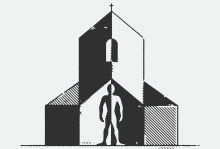
MY COLLEAGUES AND I have done extensive research on race and religion for 30 years. We’re now wrapping up an intensive, three-year national research project where we heard from thousands of Christians and examined trends in church attendance and commitment. We have a clear conclusion: God is shaking down the U.S. church. It is currently in a reckoning, the likes of which has not been seen for centuries.
As our team interviewed Christians of color across the U.S., we heard a similar and painful story repeated: White Christians, by their actions, seem to favor being white over being Christian. Christians of color cited many instances of that type of behavior, national and local, communal and personal. We wondered if this was the case empirically and, if so, why. As we tested the hypothesis, we found a plethora of evidence substantiating what we heard.
My co-author Glenn Bracey and I are proposing a theory in our forthcoming book, The Grand Betrayal: Most church-attending white Christians are not bad Christians. This is because they are not Christian at all. Instead, we propose they are faithful followers of a different religion: the “religion of whiteness.”

VLADIMIR PUTIN'S BRUTAL military intervention into Ukraine, and the Ukrainian people’s courageous stand in defense of democracy, human rights, and human dignity, will go down as one of the most consequential events of the early 21st century. While we mourn the tragic loss of life and growing humanitarian crisis caused by Putin’s invasion, the global community has an opportunity to double down on its support for civil resisters and peacebuilders in Ukraine, Russia, and Belarus while massively increasing investment in nonmilitary approaches to challenging war and tyranny around the world, including in the United States.
Sadly, I’m quite familiar with Putin’s authoritarian playbook. In 2001, I worked with a Russian human rights organization that focused on atrocities committed by Russian forces in Chechnya. At the U.S. State Department 11 years later, my work had turned to Syria when Putin backed the Assad regime in dropping barrel bombs and using chemical weapons against the Syrian people. Putin’s scorched-earth tactics and his willingness to target civilians are all too familiar, but no less despicable.
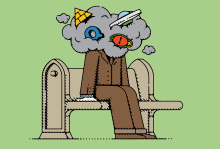
WHILE QANON, A convoluted conspiracy theory filling the internet with misinformation, is out of the headlines for now, we are still unpacking the damage it did to democratic principles during the 2020 presidential election. Social scientists such as ourselves have been unpacking the connection between religion and support for QAnon.
During the height of the 2020 presidential campaign, QAnon content increased by 71 percent on Twitter and 651 percent on Facebook, according to Marc-André Argentino, an associate fellow at the Global Network on Extremism and Technology. In a report released in May 2021 by the Public Religion Research Institute (PRRI), 15 percent of Americans agreed with the sweeping QAnon allegation that “the government, media, and financial worlds in the U.S. are controlled by a group of Satan-worshipping pedophiles who run a global child sex trafficking operation.” The majority of Americans (82 percent) disagreed with the statement. Men and lower-income Americans were more supportive. To be clear, the vast majority of Americans (84 percent) have an unfavorable view of QAnon. Nearly three-quarters say that QAnon is bad for the nation.
However, 23 percent of white evangelical Protestants, a core Republican Party constituent group, are QAnon believers, according to PRRI.

TENT OF NATIONS, a 100-acre farm southwest of Bethlehem in the West Bank, Palestine, has been in the Nassar family since their grandfather bought it more than a century ago. The family’s attempts to hold onto their land and prevent settlers from taking it over has been an ongoing battle—not only within the realm of the legal system. The Nassar family has had to physically defend their land, nonviolently, from repeated encroachments and attacks, which have included the burning and uprooting of their olive trees, the bulldozing of their plants, harassment and intimidation, and constant attempts to destroy the few physical structures they set up. The family’s persistence in remaining on the land has been one of the most remarkable examples of Palestinian sumud (or steadfastness) I have seen.
The story of their resistance is not just a political story of one Palestinian family’s assertion of its ancestral rights. The Nassar family members are devout Lutherans, deeply committed Christians who attempt to live out their faith in practice. They have used their property as a tangible example of their Christ-centered commitment to peace, reconciliation, and nonviolence.

AFTER THE SOLEMN journey of Lent, through which we embrace the mystery of the death of Jesus Christ, we enter the mystery of Easter, a new life. And as we celebrate Easter, we cannot remain in the feelings of fear and anxiety, which merely lead us into inaction. All the gospels’ Easter narratives include the empty tomb. Our standing in front of the empty tomb symbolizes our standing at the threshold to new life. For example, in John’s gospel we imaginatively encounter Mary Magdalene, who runs to the grave with spices to prepare for Jesus’ funeral while continuing to be sad. However, at the dawn of Easter she hears Jesus say, “Do not hold onto me.”
At the very familiar space of death, representing deep feelings of despair, Jesus’ voice introduces a cut or prohibition and indicates that the old way cannot continue to operate beyond this point. Upon hearing this, Mary must face the empty tomb, which signifies a lack or a hole. The starting point, then, from which to walk into the paschal mystery, can be the acknowledgment that the lack of full wisdom, perfection, and completeness is the reality of the self and the world. Often, we experience resistance to moving or walking onto a new or unknown path, while still fully knowing a new life is waiting. The life of resurrection commands us to step into the resurrected body of Jesus Christ. In this pandemic-ridden time, what does it mean to walk into the new life of the Risen Christ?
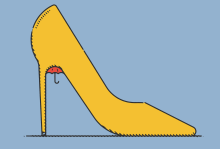
A WOMAN I know was arrested on her birthday for the crime of solicitation for prostitution—agreeing to a sex act for money. She spent 18 days in jail, enough time for a brutal detox from the synthetic opioid fentanyl.
Tara (name changed to protect her identity) is not an empowered sex worker, at least not in the way that sex worker rights activists would like to describe her in their vehemence against her arrest. Nor does Tara identify as a sex trafficking “victim” or “survivor.” She would tell you that she chose the street life and all that comes with it.
Though I am constantly learning from my friends in the sex trade, here is what I understand after spending 10 years with this population:
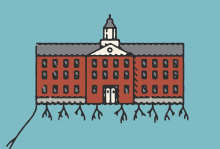
“PRAYER AND PROTEST are not two different things.” Princeton Theological Seminary professor Keri L. Day’s proclamation—part of a rousing sermon she preached on the first day of Black History Month—provoked applause and amens from students gathered for worship in the newly renamed Seminary Chapel.
These seminarians recognized the truth of Day’s words because they had galvanized a prayerful protest to change the name of what had been known—for 129 years—as Miller Chapel. The building name honored Samuel Miller, a white Presbyterian minister who in 1813 became the second professor at Princeton Seminary. Like many of the institution’s founders, Miller preached “the enormity of the evil” of chattel slavery yet opposed the movement for immediate abolition. Miller was also an enslaver who held a number of people in bondage during his tenure at the seminary. Miller believed that Black people “could never be trusted as faithful citizens.” He played a key role in making Princeton Seminary the unofficial theological headquarters of the American Colonization Society, formed in 1817 to send free African Americans to Africa as an alternative to multiracial democracy.
Recently the seminary has begun to reckon with this past. In 2018 the institution published a report documenting and confessing its sinful “connections to slavery.” In 2019 the board of trustees made a $27.6 million investment in a range of initiatives that seminary president M. Craig Barnes characterized as “the beginning of our community’s journey of repair.”

ACTS OF ANTISEMITISM in the U.S. are skyrocketing. In October 2021, the American Jewish Committee released data from the largest-ever survey of Jews in the U.S. showing that during the previous 12 months, 1 in 4 Jews experienced antisemitism and 39 percent altered their behavior—such as avoiding wearing items that would identify them as Jewish—out of fear of antisemitism.
In less than four years, the U.S. has seen at least three violent antisemitic attacks on Jewish houses of worship. Eleven people were killed in 2018 at the Tree of Life synagogue in Pittsburgh as a gunman screamed antisemitic slurs. Six months later, a man “inspired” by the massacre at the Tree of Life synagogue attacked a synagogue near San Diego. This January, an armed man spouting antisemitic conspiracy theories took hostages during the Shabbat service at Congregation Beth Israel near Dallas.
While many Christians take note of this disturbing trend with dismay, most haven’t learned how Christianity has been weaponized against Jewish people.